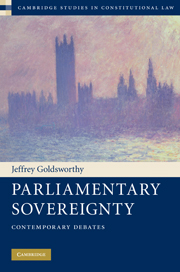Book contents
- Frontmatter
- Contents
- Detailed table of contents
- Acknowledgments
- 1 Introduction
- 2 The myth of the common law constitution
- 3 Legislative sovereignty and the rule of law
- 4 Homogenising constitutions
- 5 Abdicating and limiting Parliament's sovereignty
- 6 Trethowan's case
- 7 Requirements as to procedure or form for legislating
- 8 Judicial review, legislative override, and democracy
- 9 Parliamentary sovereignty and statutory interpretation
- 10 Challenging parliamentary sovereignty: Past, present and future
- Index
- References
8 - Judicial review, legislative override, and democracy
Published online by Cambridge University Press: 05 October 2010
- Frontmatter
- Contents
- Detailed table of contents
- Acknowledgments
- 1 Introduction
- 2 The myth of the common law constitution
- 3 Legislative sovereignty and the rule of law
- 4 Homogenising constitutions
- 5 Abdicating and limiting Parliament's sovereignty
- 6 Trethowan's case
- 7 Requirements as to procedure or form for legislating
- 8 Judicial review, legislative override, and democracy
- 9 Parliamentary sovereignty and statutory interpretation
- 10 Challenging parliamentary sovereignty: Past, present and future
- Index
- References
Summary
The ‘notwithstanding clause’
Section 33 of the Canadian Charter of Rights famously provides that Canadian legislation ‘may expressly declare … that the Act or a provision thereof shall operate notwithstanding a provision included in section 2 or sections 7 to 15 of this Charter’. This ‘notwithstanding’ or ‘override’ clause enables legislatures to override those specified sections of the Charter, and the rights they protect, although only for renewable five-year periods.
Section 33 is said to have been ‘included in the Charter for the very purpose of preserving parliamentary sovereignty on rights issues’. But this exaggerates its effect. It is limited in scope, and by no means preserves the law-making powers previously enjoyed by Canadian parliaments. It does not authorise the amendment or repeal of any provisions of the Charter; it does not authorise the override of all Charter rights; and it authorises override only for five-year periods.
Many supporters of the Charter have strongly criticised s. 33 on the predictable ground that it is incompatible with the main purpose of constitutionally entrenching rights. As they see it, that purpose is to protect rights from being overridden by legislation – in other words, to prevent precisely what s. 33 expressly permits. On their view, what the Charter purports to grant with one hand, it takes away with the other.
- Type
- Chapter
- Information
- Parliamentary SovereigntyContemporary Debates, pp. 202 - 224Publisher: Cambridge University PressPrint publication year: 2010



